
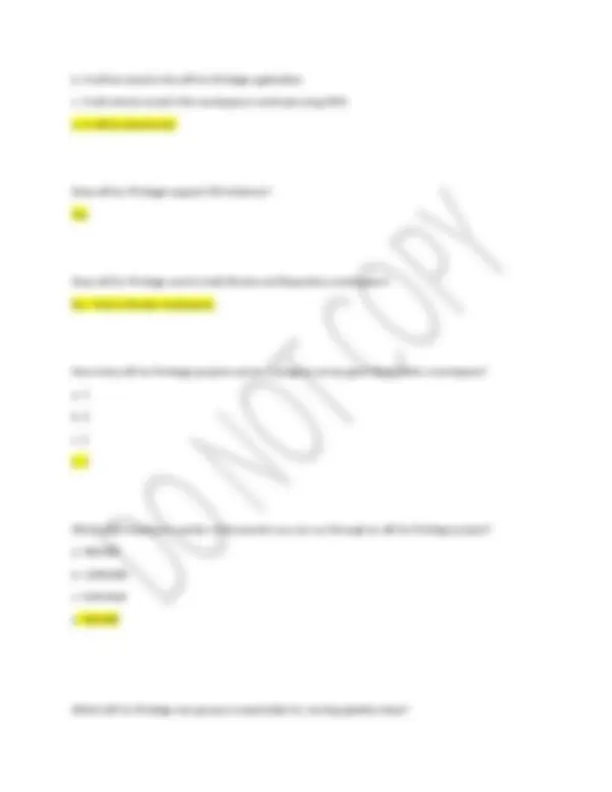

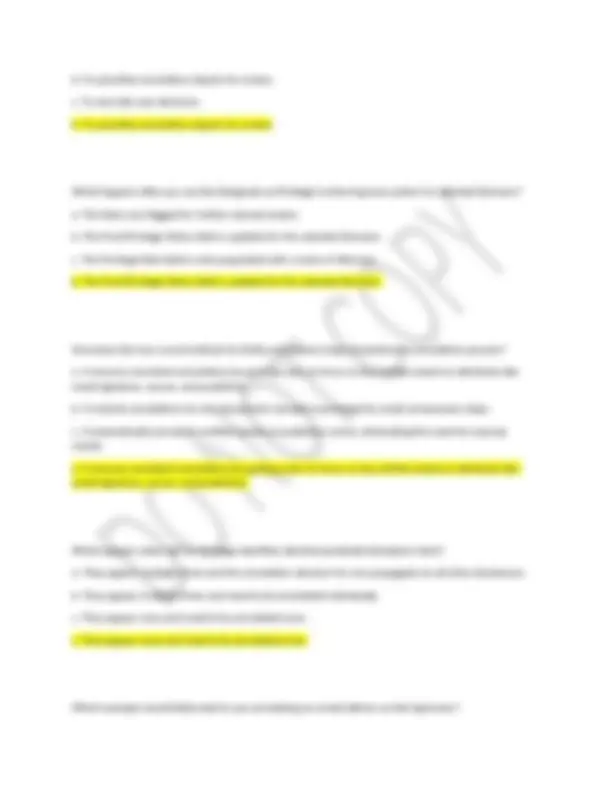
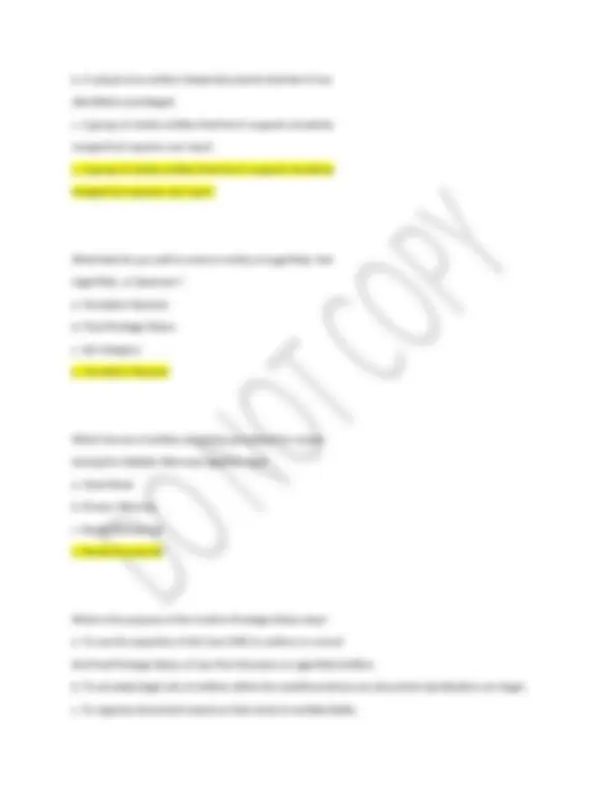
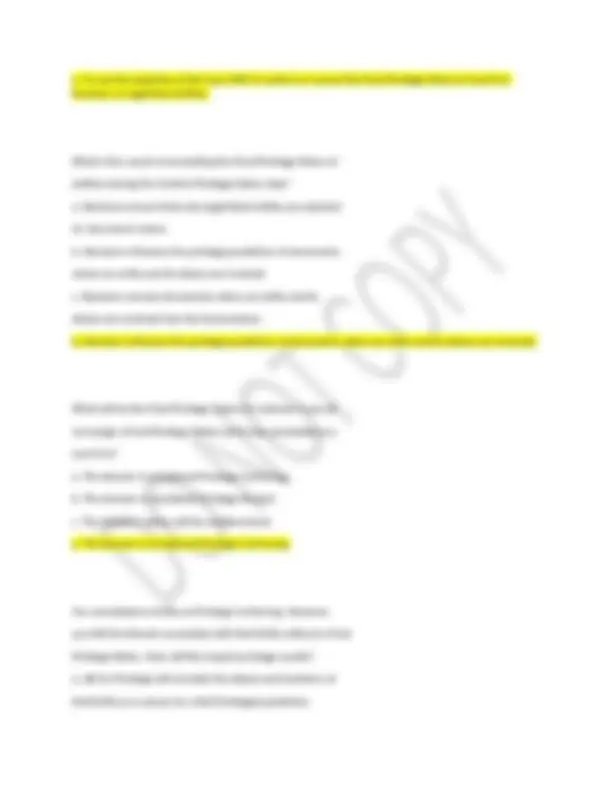
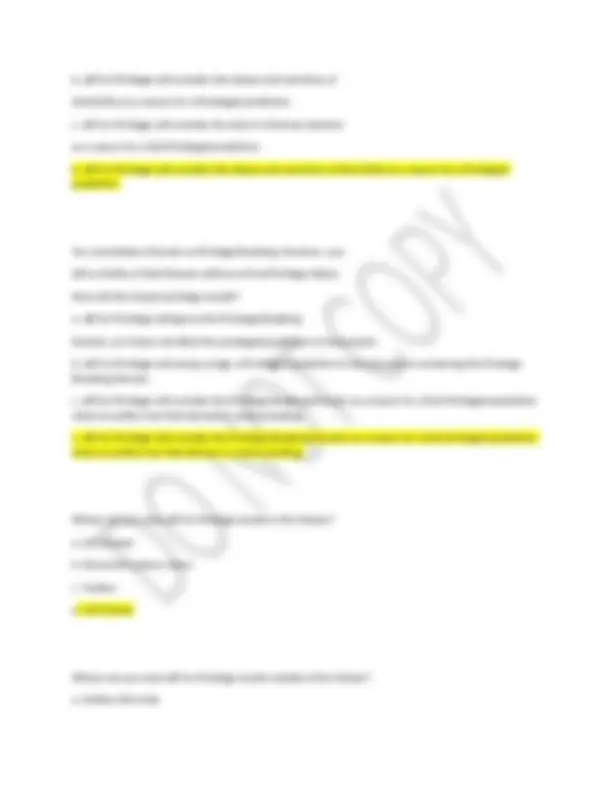
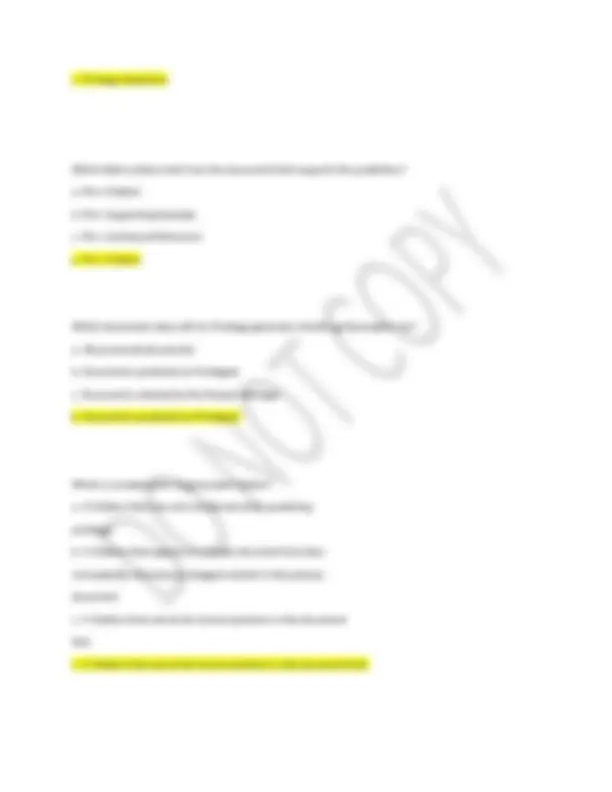
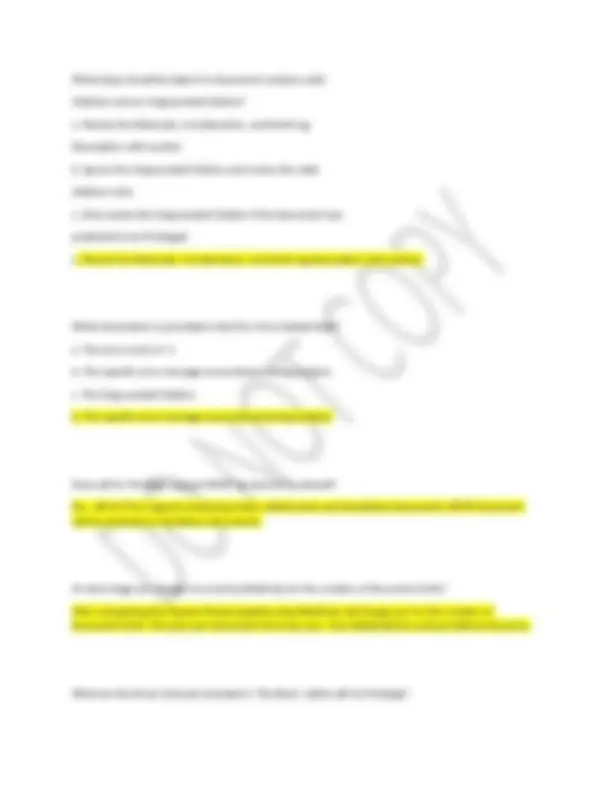




Study with the several resources on Docsity

Earn points by helping other students or get them with a premium plan


Prepare for your exams
Study with the several resources on Docsity

Earn points to download
Earn points by helping other students or get them with a premium plan
Community
Ask the community for help and clear up your study doubts
Discover the best universities in your country according to Docsity users
Free resources
Download our free guides on studying techniques, anxiety management strategies, and thesis advice from Docsity tutors
Relativity air for Privilege Pro (july 2025)Relativity air for Privilege Pro (july 2025)
Typology: Exams
1 / 18

This page cannot be seen from the preview
Don't miss anything!











What does aiR for Privilege utilize to identify privileged documents? a. It uses multiple AI algorithms. b. It uses users' previous privilege codings. c. It uses user prompts for their projects. a. It uses multiple AI algorithms How does aiR for Privilege identify privileged documents that are often missed by traditional privilege screens? a. It identifies unknown entities without a legal role. b. It identifies law firms and attorneys not on the known items list. c. It identifies known law firms and attorneys. b. It identifies law firms and attorneys not on the known items list. What is a method aiR for Privilege uses to automate first pass review? a. Searching using regular expressions. b. Building a social network graph. c. Using a seed set of coded documents. b. Building a social network graph. How do privilege results influence second pass privilege review? a. The results help users prioritize documents for the review and decide whether a document is privileged. b. The results help users prioritize documents for the review and aiR for Privilege decides whether a document is privileged on behalf of the user.
c. The results help aiR for Privilege prioritize documents for the review and decide whether a document is privileged on behalf of the user. a. The results help users prioritize documents for the review and decide whether a document is privileged. What is the primary purpose of the Brain in Relativity aiR for Privilege? a. To manage user access permissions. b. To generate new annotations without user input. c. To accelerate annotation time and ensure consistency across document predictions. c. To accelerate annotation time and ensure consistency across document predictions. What information does the Client Brain store? a. Draft Log Descriptions b. Document Extracted Text c. Annotator Decisions c. Annotator Decisions How do you know if an item was found in the Client Brain? a. It does not have an Annotator Decision. b. It has a Source value of Known Attorney. c. It has a Source value of Client Brain. c. It has a Source value of Client Brain. What happens to an in progress aiR for Privilege Project when a workspace is deleted? a. It will be abandoned.
a. Project Manager b. Annotator c. Case SME a. Project Manager Which field is required when adding a Known Law Firm? a. Alternative Name b. Domain c. Known Attorneys b. Domain Which Annotation object does not have a Prediction field? a. Spammers b. Domains c. Equivalent Domains c. Equivalent Domains During which round of Validate Attorneys will the Prediction field on the Entity object not be populated? a. Round 1 b. Round 2 c. Round 3 a. Round 1 How should you use the Prediction field when annotating? a. To use as the default value without QCing.
b. To prioritize annotation objects for review. c. To override user decisions. b. To prioritize annotation objects for review. What happens after you use the Designate as Privilege Conferring mass action for selected Domains? a. The items are flagged for further manual review. b. The Final Privilege Status field is updated for the selected Domains. c. The Privilege Role field is auto-populated with a value of Attorney. b. The Final Privilege Status field is updated for the selected Domains. How does the four-round method for Entity annotations help streamline the annotation process? a. It ensures consistent annotations by guiding users to focus on key entities based on attributes like email signature, source, and prediction. b. It restricts annotations to only documents marked as privileged to avoid unnecessary steps. c. It automatically annotates entities based on prediction scores, eliminating the need for manual review. a. It ensures consistent annotations by guiding users to focus on key entities based on attributes like email signature, source, and prediction. What happens when aiR for Privilege identifies identical predicted disclaimer texts? a. They appear multiple times and the annotation decision for one propagates to all other disclaimers. b. They appear multiple times and need to be annotated individually. c. They appear once and need to be annotated once. c. They appear once and need to be annotated once. Which example would likely lead to you annotating an email address as Not Spammer?
What additional field must be populated when annotating a Domain as a Law Firm? a. Organization Name b. Confidence c. Privilege Conferring a. Organization Name What is the purpose of matching equivalent domains? a. To merge unrelated email domains into one unified dataset for processing. b. To determine whether individuals communicating under both domains may be the same person. c. To automatically generate privilege predictions for documents that contain certain domains. b. To determine whether individuals communicating under both domains may be the same person. Which field indicates the number of entities shared between two domains? a. Similarity Value b. Impacted Aliases c. Matched Aliases b. Impacted Aliases What does a Cluster ID indicate? a. A group of entities that have been identified by the AI as a social network.
b. A subset of an entity's linked documents that the AI has identified as privileged. c. A group of similar entities that the AI suspects should be merged but requires user input. c. A group of similar entities that the AI suspects should be merged but requires user input. What field do you edit to mark an entity as Legal Role, Not Legal Role, or Spammer? a. Annotator Decision b. Final Privilege Status c. Job Category a. Annotator Decision Which Source of entities should be prioritized for review during the Validate Attorneys pipeline step? a. Client Brain b. Known Attorney c. Newly Discovered c. Newly Discovered What is the purpose of the Confirm Privilege Status step? a. To use the expertise of the Case SME to confirm or correct the Final Privilege Status of Law Firm Domains or Legal Role Entities. b. To annotate legal role of entities within the workflow before any document classification can begin. c. To organize documents based on their level of confidentiality.
b. aiR for Privilege will consider the aliases and mentions of that Entity as a reason for a Privileged prediction. c. aiR for Privilege will consider the lack of a Domain decision as a reason for a Not Privileged prediction. b. aiR for Privilege will consider the aliases and mentions of that Entity as a reason for a Privileged prediction. You annotated a Domain as Privilege Breaking. However, you left an Entity of that Domain without a Final Privilege Status. How will this impact privilege results? a. aiR for Privilege will ignore the Privilege Breaking Domain, as it does not affect the privileged prediction of documents. b. aiR for Privilege will always assign a Privileged prediction to any document containing the Privilege Breaking Domain. c. aiR for Privilege will consider the Privilege Breaking Domain as a reason for a Not Privileged prediction when an entity from that domain is communicating. c. aiR for Privilege will consider the Privilege Breaking Domain as a reason for a Not Privileged prediction when an entity from that domain is communicating. Where can you view aiR for Privilege results in the Viewer? a. Left drawer b. Document actions menu c. Toolbar a. Left drawer Where can you view aiR for Privilege results outside of the Viewer? a. Entities (Priv) tab
b. Document List c. Projects (Priv) tab b. Document List How can you view your privilege log report? a. Navigate to the Privilege Log Report tab in the application. b. Navigate to the Document Viewer. c. Create a custom view containing only privileged documents and the required fields. c. Create a custom view containing only privileged documents and the required fields. How does aiR for Privilege determine the privilege prediction of documents? a. By analyzing the content of the document and its family members. b. By reviewing all documents with a prediction of Privileged and their family members simultaneously. c. By analyzing the text within the four corners of each document using the context that was built during the pipeline. c. By analyzing the text within the four corners of each document using the context that was built during the pipeline. Which is not an expected Priv::Prediction field result? a. Privileged b. Borderline
c. Privilege Redaction Which field contains text from the document that supports the prediction? a. Priv::Citation b. Priv::Supporting Example c. Priv::Contextual Reference a. Priv::Citation Which documents does aiR for Privilege generate a Draft Log Description for? a. All processed documents. b. Documents predicted as Privileged. c. Documents selected by the Project Manager. b. Documents predicted as Privileged. What is considered an Ungrounded Citation? a. A Citation that was not considered when predicting privilege. b. A Citation that appears in a family document but does not explicitly reference privileged content in the primary document. c. A Citation that cannot be found anywhere in the document text. c. A Citation that cannot be found anywhere in the document text.
What steps should be taken if a document contains valid Citations and an Ungrounded Citation? a. Review the Rationale, Consideration, and Draft Log Description with caution. b. Ignore the Ungrounded Citation and review the valid citations only. c. Only review the Ungrounded Citation if the document was predicted to be Privileged. a. Review the Rationale, Consideration, and Draft Log Description with caution. What information is provided in the Priv::Error Details field? a. The error score of -1. b. The specific error message encountered during analysis. c. The Ungrounded Citation. b. The specific error message encountered during analysis. Does aiR for Privilege support RSMF documents by default? No - aiR for Priv supports analyzing emails, attachments and standalone documents. RSMF document will be analyzed as standalone documents. At what stage are charges incurred by Relativity for the number of Document Units? After completing the Prepare Project pipeline step Relativity will charge you for the number of Document Units. The price per Document Unit may vary. Your RelativityOne contract defines the price. What are the three (3) levels included in 'The Brain' within aiR for Privilege?
Do documents selected for an air for Privilege project need a value in the 'Extracted Text Size in KB' field? Yes - It must also be between 0.05 KB and 170 KB What should you do with RSMF documents in air for Privilege? Remove RSMF documents or confirm that the extracted text on your RSMF documents contain valid email headers (from, to, date, subject, etc.) Make those documents have a Record Type value of email. What are the eight (8) Project pipeline steps?
Prepare Project
Scrub Disclaimers
Identify Spammers
Classify Domains
Match Equivalent Domains
Validate Attorneys
Confirm Privilege Status
Populate Privilege Results What is meant by 'Performing Annotations'? Certain pipeline steps require you to confirm the predictions made by the AI, which is called performing annotations. This increases the accuracy of the system and ensures privileged documents are not missed. What are 'Entities' in aiR for Privilege projects?
Entities are the individuals communicating within the data set. They communicate by way of their aliases, which are most commonly full email addresses, user ids, short names, and appear within the documents being analyzed. In which pipeline step do you annotate 'Entities'? During the Validate Attorneys pipeline step our AI will group the aliases in the data set under a specific entity and then make an AI prediction as to whether the entity is playing a Legal Role in the matter. How many rounds of annotation must be completed as part of the 'Validate Attorneys' step of the pipeline? Four (4) - Each round consists of annotating entities and then performing the Apply Annotations Action as specified in Validate Attorneys. At what step of the pipeline should you edit the 'Final Privilege Status' field on the Domain or Entity object? Only when the Confirm Privilege Status pipeline step has a status of 'Ready to Apply Annotations' What is meant by the following terms: